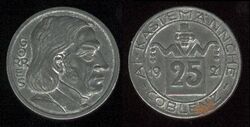| 25 pfennig | |
|---|---|

| |
| 1921 coin | |
| General information | |
| Country | |
| Used by | |
| Value |
0.25 mark |
| Years |
|
| Measurements and composition | |
| Mass |
|
| Diameter |
24 mm |
| Composition |
iron |
| Appearance | |
| Shape |
round |
| Obverse |
|
| Reverse |
|
| v · d · e | |
The 25 pfennig coin was issued by the town of Koblenz (at the time with a "C" in lieu of a "K" in the name) in 1918 and 1921. It had a value equal to 0.25 Papiermark, and was issued as war money (German: Kriegsgeld) during the first year and emergency money (German: Notgeld) during the second.
History[]

Reverse of the 1918 coin.
The first 25 pfennig coin of the city of Koblenz was issued in 1918. This coin is composed of iron, weighs approximately 5.2 grams, and measures 24 millimeters in diameter. It is very similar in design to the 1918 50 pfennig coin issued by the city. The coat of arms of Koblenz is featured on the obverse, with the legend "COBLENZ" inscribed above. "GÜLTIG BIS 1 JAHR NACH FRIEDENSSCHLUSS", which translates to "Valid until 1 year after final peace", starts at the top left of the arms and extends along the rim to its top right. The "final peace" likely refers to the end of World War I, which at the time of the coin's issuance was still an ongoing conflict. The coin's value is featured on the reverse, accompanied by the word "KRIEGSGELD", the year, and two six-pointed stars located at either side of the value. In total, at least 1,600,000 specimens were produced.
Koblenz issued its second 25 pfennig coin in 1921. In terms of measurements and composition, the coin is identical to its predecessor except for its mass, weighing 4.9 grams instead of 5.2. A large right-facing portrait of Joseph Görres (1776–1848), a famous German Catholic writer who hailed from Koblenz, is featured on the obverse, with the caption "GÖRRES" inscribed to the left. A man with a hat is featured above the coin's value (simply written as "25") in the center of the reverse. The value is enclosed within a square and separates the first two digits of the date "1921" from the last two. "COBLENZ" is inscribed at the bottom center of the coin, and above is the text "AI - KASTEMÄNNCHE". Kastemännche was a colloquialism used in Rhineland that referred to the 2½ Silbergroschen coin issued by the Kingdom of Prussia from 1842 to 1873. The word was later used in some communities to refer to 25 pfennig coins, likely because the original "Kastemännche" coin was given a value equal 0.25 marks, or 25 pfennigs, upon the introduction of the German gold mark in 1873. In total, 204,500 examples were minted, 103,300 of which are coin oriented and 101,200 are medallically aligned.
References[]
- 25 Pfennig Kriegsgeld Koblenz – Numista
- STADT COBLENZ (GERMAN) 25 PFENNIG 1921 – Cache Coins
- Germany Coblenz 25 Pfennig 1921 Notgeld Rhineland 77.6 – eBid
Template:Koblenz notgeld
